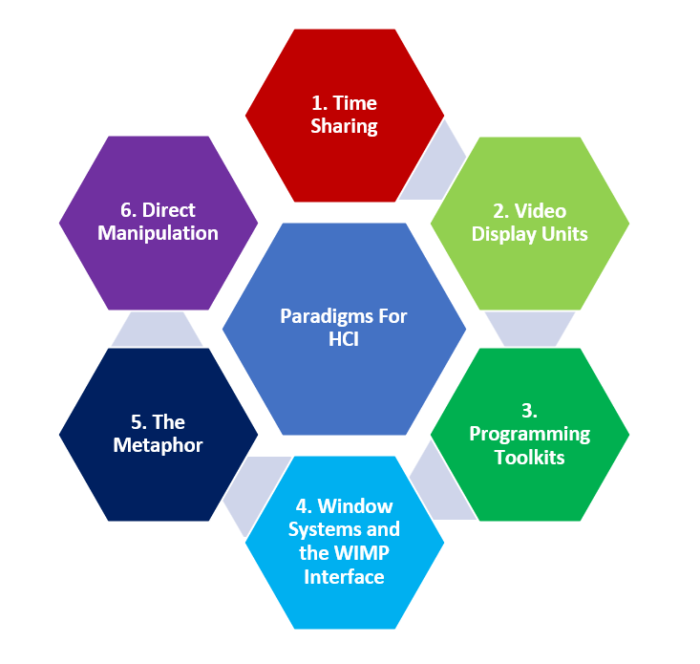We are going to cover the HCI topic which is What is HCI?
What is HCI in Technology(IT) | What Does HCI Mean
Human-Computer Interaction or HCI is the designing, assessing, and implementing interactive computing systems for human use in a social setting, as well as studying the key phenomena that surround them.
In Human-Computer Interaction or HCI, we don’t always picture a lone person using a desktop computer. The term “user” can refer to a single user, a team of users working together, or a line of users operating in succession within an organisation, each handling a different aspect of the task or process. The person employing technology to complete a task is the user.
When we use the term “computer,” we refer to any technology, including general-purpose desktop computers, large-scale computer systems, process control systems, and embedded systems. Other individuals and other non-computerized components may be a part of the system. Any form of direct or indirect communication between a user and a computer is referred to as Human-Computer Interaction. Direct involvement entails a conversation with feedback and control during task execution. Batch processing or environment control by intelligent sensors are examples of indirect interaction. The fact that the user is engaging with the computer to complete a task is crucial.
Although it has only been used often since the early 1980s, the phrase “human-computer interaction” has its roots in longer-standing fields. In factories, systematic research on human performance with a focus on manual labour started at the turn of the 20th century. The Second World War served as the catalyst for investigating how people and machines interact as both sides competed to build more potent weaponry. This sparked a surge in interest among scientists in the field, which resulted in the founding of the Ergonomics Research Society in 1949.
Ergonomists have traditionally focused their attention on the physical properties of devices and systems and how these influence user performance. These problems are included in the field of human factors, along with additional cognitive problems. The phrases are frequently used interchangeably, with human factors favoured in English-speaking North America and ergonomics preferred in the United Kingdom. Both of these fields are interested in how users interact with various systems, including computer, mechanical, and manual ones.
As the usage of computers increased, more researchers became experts in understanding how people interact with them, focusing on the theoretical, psychological, and physical components of this connection. As a result of the particular interest in computers and the demographics of the user base, this research’s initial term, man-machine interaction, was changed to Human-Computer Interaction (HCI).
Information science and technology research is a different area of study that has influenced the growth of HCI. The management and manipulation of information within an organization is the focus of the former, which is an ancient discipline that existed before the development of technology. Technology has significantly changed how information may be stored, accessed, and used. As a result, the organization and work environment have also been significantly impacted. Systems analysis has historically focused on how technology affects the workplace and how to adapt it to the demands and limitations of the position. HCI is likewise concerned about these challenges.
HCI borrows from a variety of fields, but it is in computer science and systems design that it must be acknowledged as a primary concern. It can be a specialty for all other disciplines, even though it offers essential input; for systems design, it is a crucial step in the design process. According to this viewpoint, HCI entails the design, implementation, and assessment of interactive systems in the context of the task and work of the user.
What is HCI (Human Computer Interaction) in Computer Science
What is HCI: Without a doubt, HCI is a cross-disciplinary field. The ideal interactive system designer would be knowledgeable in a variety of fields, including computer science, ergonomics, psychology, sociology, cognitive science, and engineering, which would enable them to build the necessary technology, business, which would enable them to market it, and graphic design, which would enable them to create an effective user interface.
There is obviously too much skill involved for one person and possibly even for the typical design team. Although it is acknowledged that HCI is an interdisciplinary field, in reality, people frequently favor one side over the other. Effective interactive systems cannot, however, be created solely from one discipline. We need opinions from all angles. A wonderfully designed graphic display, for instance, might not be functional if it disregards dialogue limits or the user’s psychological constraints.
HCI must at least in part be taught if it combines both craft and science. Though a designer may possess natural creativity and skill or acquire them via experience, the underlying theory must be acquired. Concentration on the interface was previously a luxury that was frequently forgone when computers were used primarily by expert professionals. Designers can no longer afford to prioritize system functioning above interface because the two are too interwoven. Poor interface design hides functionality; good interface design enables system functionality to support the user’s task.
Thus, computer science education can no longer afford to ignore HCI. We would even go so far as to say that HCI ought to be included in every computer science or software engineering degree, preferably as a standalone subject rather than just a repeating element of other modules. It must not be considered an “optional extra” (although, of course, more advanced HCI options can complement a basic core course).
HCI may be an option in courses other than computer science that focuses on a specific subject, like task analysis or cognitive modelling. If designers and educators want to combine the need for more complexity in the system with improved clarity and usability in the interface, HCI must be considered seriously.
What is Human-Computer Interaction (HCI) Framework?
Human-Computer Interaction (HCI) Frameworks offer a way to talk about the specifics of a given interaction and a foundation for talking about other topics that are connected to it.
These elements are depicted in Figure in relation to the interaction framework. The study of ergonomics focuses in particular on problems with user interfaces, including input, output, and the user’s immediate environment. As they handle both articulation and performance, dialogue design and interface styles can be positioned specifically along the input branch of the architecture. Dialog, on the other hand, is slanted toward the side of the framework that is more frequently connected with the computer.
The output branch of the framework is related to presentation and screen design. A social and organizational context that influences the interaction can be used to situate the entire framework. The design of interactive systems and user performance are significantly impacted by each of these categories.
Paradigms For Human-Computer Interaction (HCI)
- Time Sharing
The idea of time sharing, which allows for the usage of numerous users on a single computer, was one of the most significant innovations to result from this shift in research concentration. The human (or, more precisely, the programmer) was previously limited to batch sessions, in which finished projects were sent on punched cards or paper tape to an operator who subsequently ran them on computer. The time-sharing systems of the 1960s made programming a real interactive activity and gave rise to a group of programmers known as “hackers” who were obsessive, detail-oriented masters who delighted in comprehending complexity.
- Video Display Units
Researchers began experimenting with the idea of displaying and modifying information from a computer in the form of graphics on a video display device in the middle of the 1950s. These display displays might be a better medium for conveying massive amounts of strategic information for quick assimilation than a paper printout. The Semi-Automatic Ground Environment (SAGE) project of the US Air Force was one of the earliest military applications for display screen images.
- Programming Toolkits
Programming toolkits are powerful because they allow for the fixed composition of tiny, well-understood components to produce larger tools. Once these bigger tools have been mastered, they can then be combined with other tools to create new tools, and so on.
- Window Systems and the WIMP Interface
The WIMP interface, which uses windows, icons, menus, and pointers for interaction, is currently widely used. When Xerox Corporation unveiled the 8010 Star Information System in April 1981, these interface devices made their debut appearance on the market. However, Engelbart’s group at NLS and Xerox PARC used many of the interface techniques necessary for a windowing system in the Alto, an experimental system that served as Star’s forerunner.
- The Metaphor
Children were easily able to relate to the real-world phenomena, and this rapid familiarity helped them to comprehend how to make pictures. With great success, metaphors are employed to explain new ideas in terms of well-known ones. It is hardly surprising that this general training approach has been effective in exposing computer newbies to very exotic interaction methods.
- Direct Manipulation
Characteristics of a direct manipulation interface include:
- Visibility of the relevant objects
- Progressive interaction with immediate feedback on every move
- Reversibility of all acts to allow users to explore without fear of punishment
- All actions must be syntactically valid in order for them to be legal
- Sophisticated command languages with operations that directly change the observable objects (and, hence, the name direct manipulation)
Here we covered What is HCI and framework etc.



